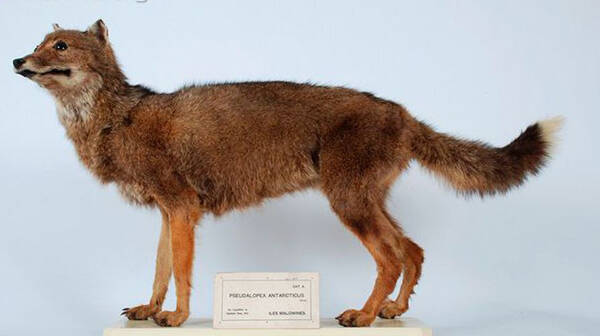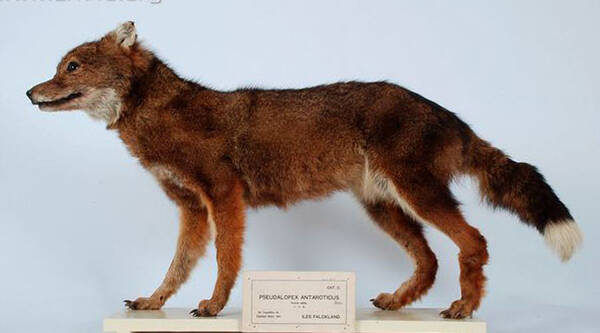Dusicyon australis
IUCN
LCBasic Information
Scientific classification
- name:Dusicyon australis
- Scientific Name:Dusicyon australis
- Outline:Carnivora
- Family:Schizopoda Canidae Servalinae South American jackal
Vital signs
- length:97About cm
- Weight:50kgabout
- lifetime:12-15 years
Feature
The world's southernmost wolf has gone extinct
Distribution and Habitat
The Falkland Islands wolf, also known as the Antarctic wolf, is found only on the Falkland Islands.
Appearance
The head of the Falkland Islands wolf is 97 cm long, and the tail is 28.5 cm long. It looks very similar to a dog, but the eyes are slanted, the mouth is slightly wider, and the snout is pointed; the tail is shorter, never curled up, and hangs between the hind legs; the ears are erect and not bent. In order to survive, this species has become sharper in the long process of evolution, which can easily tear food apart and swallow it in large mouthfuls without chewing it; the molars have also been very adapted to the needs of cutting meat and gnawing bones. The fur color of this species changes with the temperature; the fur color becomes darker in summer, some are light yellow, and some are red; the fur color becomes lighter in winter, and some even turn white.
Details
The Falkland Islands Wolf (scientific name: Dusicyon australis) is a species of Canidae that became extinct in 1876 (on West Falkland Island). The closest relative is the South American gray fox that lives in Patagonia, Argentina, which was also introduced to the Falkland Islands in modern times.

Before the 19th century, a kind of wolf lived on the Falkland Islands west of Santa Cruz Province, the southernmost tip of Argentina. Because the Falkland Islands are very close to the Antarctic Circle, zoologists named this kind of wolf the Antarctic wolf. The Antarctic wolf can be said to be the southernmost wolf in the world.
The Falkland Islands have a tortuous coast, are humid and foggy, and have vast grasslands and abundant water and grass. By the end of the 18th century, animal husbandry here had been quite developed, and most of the islanders were engaged in animal husbandry. The vast grasslands and a wide variety of herbivores and rodents here also provide a good living space and food source for the Falkland Islands wolf.
In March 2013, researchers at the University of Adelaide found the answer to one of the most difficult mysteries in natural history: the origin of the extinct Falkland Islands wolf and how they became the only land mammal on the isolated island of the Falkland Islands (called the Malvinas Islands in Argentina) (460 kilometers away from the nearest land, Argentina). The 320-year-old mystery was first posed by British explorers in 1690 and later by Darwin after he arrived on the HMS Beagle in 1834. Researchers at the Australian Centre for Ancient DNA at the University of Adelaide extracted small amounts of skull tissue from a sample Darwin personally collected. They also used a sample that was rediscovered in the attic of the Otago Museum in New Zealand.

The research report published in the online version of Nature Communications pointed out that contrary to previous theories, the Falkland wolf was isolated during the last glacial maximum about 16,000 years ago. "Previous studies of ancient DNA from museum specimens have concluded that the Falkland Islands wolf evolved from its closest relative, the maned wolf, about 7 million years ago. It is thought that these wolves arrived on the islands about 330,000 years ago through unknown means," said Jeremy Austin, deputy director of the center. "Critically, however, these studies did not consider an extinct species of Dusicyonavus from the mainland. Scientists extracted DNA from six Dusicyonavus specimens collected in Argentina and Chile and compared it with multiple extinct and living species belonging to the same species." Research published in the journal Mammalian Reviews in 2017 showed that the Falkland Islands wolf was more like a fox than a fox or a wolf in terms of skull shape and feeding habits. By browsing fossils in South America, scientists found that its direct ancestor was an extinct fox called Dusicyon avus.
Listed in the 2015 IUCN Red List of Threatened Species ver 3.1 - Extinct (EX).
Protect wild animals and eliminate game.
Maintaining ecological balance is everyone's responsibility!








